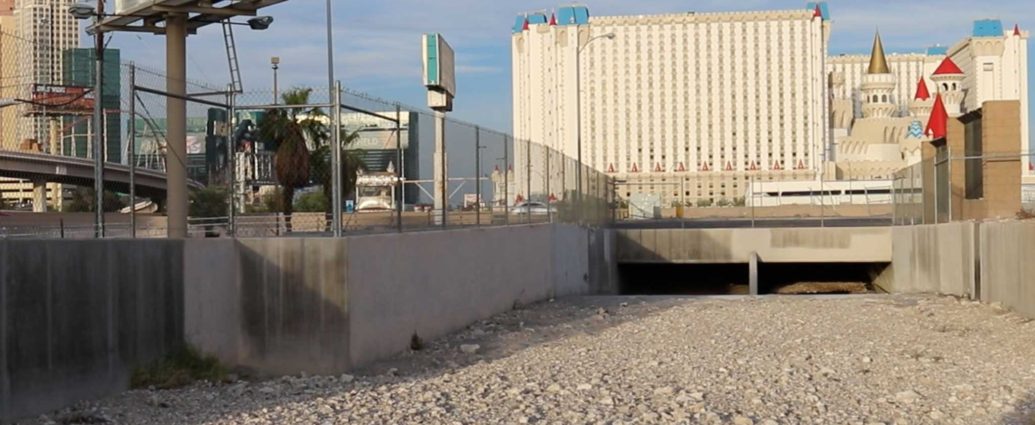Las Vegas is an oasis of dazzling light set within the vast Mojave Desert in the US state of Nevada. Fortunes are won and lost nightly in the seemingly endless casinos that make up the public face of the city. A population boom occurred in 1931 when construction of the nearby Boulder Dam (now Hoover Dam) began. Las Vegas’ celebrated history of attracting society”s entertainment elite, to both perform and be seen, began with the city’s construction of the first casinos and theaters. Classic greats like Elvis Presley, Frank Sinatra and Jerry Lewis ushered in the ‘modern’ city and paved the way for contemporary entertainers like David Copperfield, Tom Jones and Penn & Teller.
However, today, beneath the world of gambling, decadence and light lies a darker world; where the only gamble is one of survival. Las Vegas’ labyrinth of flood channels is home to hundreds of homeless people.
Las Vegas is situated in a valley almost completely surrounded by mountain ranges, with only a single outlet to the east into Lake Mead. All rainwater flowing into the valley, or deposited by sudden localised weather events, needs to be channeled away to minimise property damage and injury. Construction of the channel system began in 1988 and as of 2013, 935 kilometers of channels and underground storm drains have been built.
The homeless of Las Vegas that live within the flood control system beneath the city are susceptible to the flash flooding that their shelter was constructed to deal with. Since 1960, there have been 32 deaths attributed to flash flooding with many more injuries and others needing rescue from the turbulent water. Apart from the fast-moving water itself, the meagre possessions of the homeless (old mattresses, shopping carts and couches) become projectiles that can drag a person under, making rescue almost impossible.
The regular influx of gamblers and visitors can be a source of income for Las Vegas’ homeless. Begging (panhandling) after dark is an important revenue stream. There is hope of attracting the attention of a drunken, winning gambler who might deposit some of their winnings in a celebratory haze. Others rifle through garbage bins and alleys looking for money and possessions dropped by distracted visitors to the city.
The flip-side to these small gains is easy access to the same gambling, alcohol and drugs that Las Vegas’ visitors indulge in. Too many of the homeless use what little money they gain on ways to numb their pain. The allure of a life-changing win also drives many homeless to gamble what little money they scavenge. It is a ruthless cycle that does not always start with gambling, but can become entrenched by it. Research conducted by the University of Cambridge found that homeless people can be up to “10 times more likely than the general population to suffer from gambling related problems”.
Some homeless manage to find low-paying jobs, but the income does not cover the expenses of living in an apartment. Basic expenses such as rent, water, electricity etc makes it difficult for many of Las Vegas’ homeless to escape.
Homeless people are more susceptible to consuming alcohol and other drugs. An Australian Institute of Health and Welfare report (updated in 2018), Alcohol, tobacco & other drugs in Australia, found that “there is a strong link between problematic alcohol or other drug use and experiences of homelessness”. Also noted in the report is that homeless people are far more likely than the general population to be smokers and, unsurprisingly, will also have poorer health.
According to the Australian Red Cross, there are a number of ways that individuals, organisations and government can help homeless people find a way out. These include:
- Finding more suitable and safer accommodation.
- Building life skills and providing training.
- Providing regular meals and other support.
- Defining dedicated pathways out of homelessness.
- Mentoring and dedicated guidance.
- Connecting the homeless with family and friends who can help.
